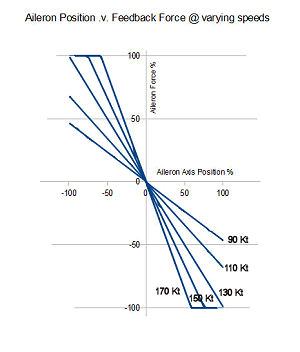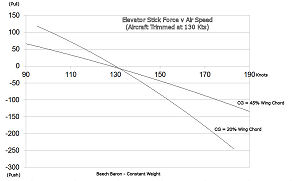BFF Control Loader (Force
Feedback) - Selected Behaviours
Aileron Stiffness
and varying Airspeed
"At low airspeeds, the
controls usually feel soft and sluggish, and the airplane
responds slowly to control applications. At high speeds, the
controls feel firm and the response is more rapid." (Pilot's
Encyclopedia of Aeronautical Knowledge, FAA, 2007).
The spring-like feel of flight
controls is mainly due to the force required to displace a
control surface into the moving airstream – the larger the
displacement the larger the force required. A neutral force
position exists to which the surface is returned by the
airstream when it is released.
Further, as airspeed increases,
the force required to displace the control surface into the
airstream by a set amount also increases. This ratio of
force to displacement is the control "stiffness". In flight
controls stiffness usually increases with increasing
airspeed – hence the FAA statement above.
In conventional
sprung joysticks the spring stiffness is constant – ie they
behave like real flight controls which are operating at the
same airspeed all the time. There is no difference in
control feel as airspeed changes.
 |
|
BFF CL System typical Aileron Stiffness Response |
In an aircraft in
which the flight controls are connected directly to the
control surfaces (such as a light GA) stiffness usually
varies with airspeed squared. If the aircraft is a
fly-by-wire type then there is no direct mechanical
connection between the controls and the control surfaces and
the relationship between stiffness and airspeed can be
anything the manufacturer wants it to be. Here stiffness
might be set to vary linearly with airspeed for example.
Both situations are definable in the BFF CL system (and
anything in between).
The graph left shows
typical BFF CL system aileron control stiffness variation
with airspeed. Each line on the graph plots aileron force
(or torque) against control displacement at a given
airspeed. As the airspeed increases, the force response
lines steepen. Here force is set proportional to airspeed
squared – it is from the BFF CL Software with FSX flying
it's default Beech Baron. If the CL configuration was set
for stiffness to vary linearly with airspeed there would be
a more gradual steepening of the force lines – as in a heavy
jet for example.
The overall effect
is soft control feel at low speeds such as on landing
approach, and tighter control feel when the aircraft is at
cruising or higher speed.
Level Flight
Elevator Forces at varying Airspeed (cf Aircraft Positive
Longitudinal Stability)
The above control
stiffness effects are also seen in the elevator axis off
course. An additional elevator axis force effect in the BFF
CL System is a further way in
which elevator forces can vary with airspeed - this time
when the aircraft is in
level flight.
The longitudinal
stability characteristics of an aircraft tend to induce
nose-up pitching when airspeed increases and nose-down
pitching when airspeed reduces.
In contrast
maintenance of level flight as airspeed increases generally requires
nose-down adjustment to reduce the wing angle of attack and
so hold the aerodynamic lift at the same level in the face
of the rising airspeed. Conversely nose-up adjustment is
needed when airspeed reduces – to increase AoA and maintain
the same overall lift at the lower airspeed.
These pitch
adjustments are made using the elevator controls off course,
and the net effect in level flight is to require increasing
push force on the elevator controls as airspeed rises above
the trimmed speed. And, increasing pull force to hold level
flight with airspeed dropping below the trimmed speed.
This control
behaviour is a requirement of the FAA eg FAR 23.173 "A
pull must be required to obtain and maintain speeds below
the specified trim speed and a push required to obtain and
maintain speeds above the specified trim speed."
Empirical and estimated data illustrating the effect can be
seen here – the graph is for a B-35 Bonanza. It shows
elevator stick force at varying airspeeds – trim was at 120
mph (zero stick force). You can see on the 1G line that to
maintain the level flight of the aircraft below 120mph the
stick has to be pulled with forces up to about 10lbf, and
above the trim speed it has to be pushed with forces up to
30lbf. (Full
article here.)
 |
|
BFF CL System typical Level Flight Elevator
Force .v. Airspeed Response |
This important elevator force
effect is implemented within the BFF CL System. The graph on
the right shows BFF CL System elevator force against
airspeed for a light GA aircraft trimmed at 130 knots in
level flight. To maintain level flight below 130 knots the
stick requires pull force, above 130 knots it needs to be
pushed. The data was for the FFB Flight Yoke with brushless
drives, running FSX and its default Beech Baron aircraft.
The force capacity
of the DIY yoke is lower than the fairly large forces
generated by the real aircraft, however the underlying
behaviour is correct. Normally off course the elevator
forces are trimmed out so that you are not left fighting the
controls just to hold level flight – the BFF CL System
allows this realistic trimming also.
The overall effect
when using the BFF CL System is that the pilot feels
changing elevator stick forces as the aircraft speed
increases or decreases in level flight consistent with the
normal positive longitudinal static stability of an aircraft. These variations
require trimming and are a useful reminder of the actual
behaviours that would be experienced in a real aircraft.
Effect on
Longitudinal Stability of Rearward CG
A characteristic
effect of loading an aircraft so that its centre of gravity
(CG) moves rearwards is to reduce its longitudinal (pitch)
stability. Eventually, if the CG is moved far enough
rearwards, the aircraft may suffer from severe pitch
oscillations and become very difficult to control - the
speed of response of the pilot's control actions becomes
insufficient to control the unstable aircraft. In extreme
cases the elevator stick forces required to control pitch can actually reverse in
direction.
The longitudinal
stability reduction associated with a more modest rearward
shift of CG shows by the elevator stick
return forces increasing less steeply when the airspeed moves away from the trimmed
airspeed. Effectively the curve shown in the above graph
becomes flatter.
 |
|
BFF CL System typical change in level flight
elevator control feel with change in aircraft CG
position. |
The graph on the
left shows this effect with the BFF CL System - it shows
elevator stick force v true airspeed for a light GA aircraft
in FSX trimmed at 130 knots and in level (1G) flight. The
steeper curve shows the response with the CG at a relatively forward
position of approx 20% of wing chord, the shallower curve
shows the effect of moving the CG rearwards to about 45% of
the wing chord. The overall aircraft weight is the same for
both flights.
You can see that the
CG = 45% out-of-trim forces are much less than those at CG =
20%. The stick returning
forces in the CG = 45% chord case are about half the
strength of those in the CG = 20% chord case for a given
difference between actual and trimmed airspeed. In the CG =
45% case the simulated aircraft was prone to strong pitch
oscillations and required much more concentration to fly.
The BFF CL System
accommodates these behaviours for aircraft with reversible
controls - the pilot will feel the correct characteristic
changes to the control feel associated with rearward shift
of the aircraft CG. Movement in airspeed away from the
trimmed airspeed will become less noticeable through the
elevator stick force when aircraft CG is moved rearward.
Although the force
levels may not match exactly those of the real aircraft the
simmer will feel the correct general behaviours in the force
feel which adds further to the realism of the flight
simulation when flight controls using the BFF CL system are
in use.
© This site is
copyrighted, If you'd like more information or have any
comments please contact me at